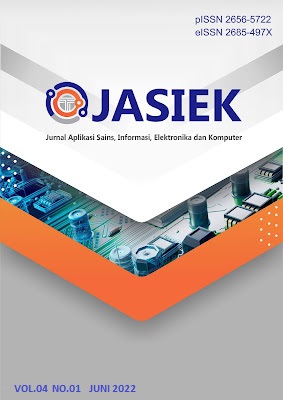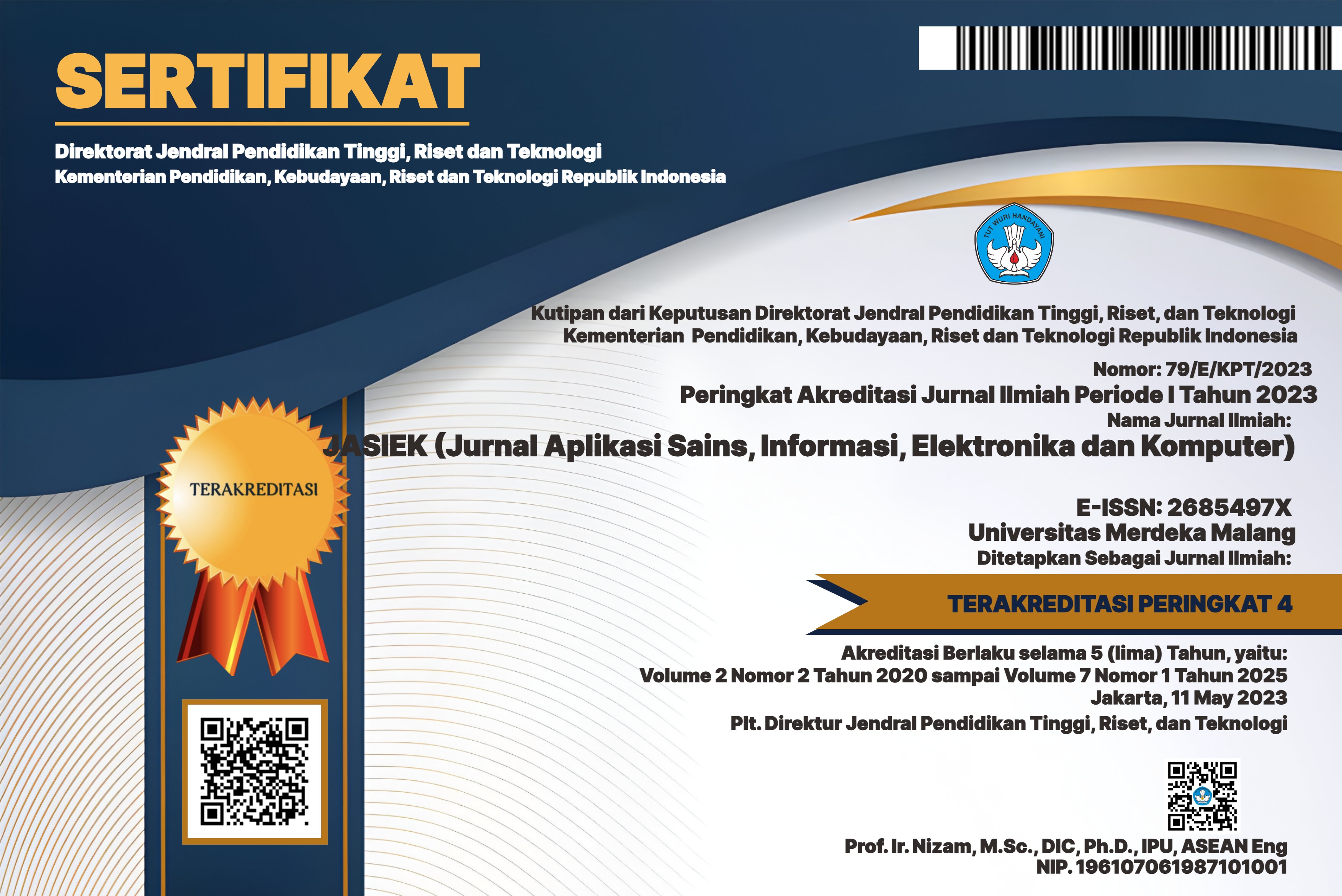Purwarupa Sistem Kendali Jarak Jauh Smart Room Berbasis Smartphone
DOI:
https://doi.org/10.26905/jasiek.v4i1.8470Keywords:
Android, Control System, ESP32, Prototype, Smart RoomAbstract
In the era of revolution 4.0 technology is developing rapidly. The control system can be integrated with new technology. Remote technology is applied in various fields. A smart room is a room that can be smartly controlled remotely. The existence of a smart room can make it easier for users to do simple work. In this study, a smart room was made with controlling lights and curtains and being able to monitor the temperature. This study uses an Android smartphone to control it. Smart room works automatically by setting a set timer via an application on an Android smartphone. Smart room prototypes can work manually and automatically. Smart room manual system via an application on an Android smartphone. In this study, the manufacture of android applications using Ionic software. The microcontroller used in designing this smart room system is using ESP WROOM 32. Utilizing the Wi-Fi feature on ESP WROOM 32 as data communication with Android smartphones.Downloads
References
J. Tarantang, A. Awwaliyah, M. Astuti, and M. Munawaroh, “Perkembangan sistem pembayaran digital pada era revolusi industri 4.0 di indonesia,†Jurnal al-qardh, vol. 4, no. 1, pp. 60–75, 2019.
D. Setiawan, “Dampak perkembangan teknologi informasi dan komunikasi terhadap budaya,†JURNAL SIMBOLIKA: Research and Learning in Communication Study (E-Journal), vol. 4, no. 1, pp. 62–72, 2018.
A. Karim, “Sejarah perkembangan ilmu pengetahuan,†Fikrah, vol. 2, no. 2, 2014.
H. Haqqi and H. Wijayati, Revolusi industri 4.0 di tengah society 5.0: sebuah integrasi ruang, terobosan teknologi, dan transformasi kehidupan di era disruptif. Anak Hebat Indonesia, 2019.
J. Kristiyono, “Budaya Internet: Perkembangan Teknologi Informasi Dan Komunikasi Dalam Mendukung Penggunaan Media Di Masyarakat,†Scriptura, vol. 5, no. 1, pp. 23–30, 2015.
F. Masykur and F. Prasetiyowati, “Aplikasi rumah pintar (smart home) pengendali peralatan elektronik rumah tangga berbasis web,†J. Teknol. Inf. dan Ilmu Komput, vol. 3, no. 1, pp. 51–58, 2016.
D. Yendri and R. E. Putri, “Sistem Pengontrolan Dan Keamanan Rumah Pintar (Smart Home) Berbasis Android,†JITCE (Journal of Information Technology and Computer Engineering), vol. 2, no. 01, pp. 1–6, 2018.
G. Sfikas, C. Akasiadis, and E. Spyrou, “Creating a Smart Room using an IoT approach,†in Proceedings of the Workshop on AI and IoT (AI-IoT), 9th Hellenic Conference on Artificial Intelligence, Thessaloniki, Greece, 2016, pp. 18–20.
R. Rizky, Z. Hakim, A. M. Yunita, and N. N. Wardah, “Implementasi Teknologi Iot (Internet of Think) Pada Rumah Pintar Berbasis Mikrokontroler Esp 8266,†(JurTI) Jurnal Teknologi Informasi, vol. 4, no. 2, pp. 278–281, 2020.
E. Ihsanto and M. F. Rifky, “Rancang bangun kendali gordeng dengan saklar lampu otomatis berbasis smartphone Android,†Jurnal Teknologi Elektro, vol. 6, no. 1, p. 143329, 2015.
Downloads
Published
Issue
Section
License
Authors who publish with this journal agree to the following terms:
The journal allow the authors to hold the copyright without restrictions and allow the authors to retain publishing rights without restrictions.
Authors retain copyright and grant the journal right of first publication with the work simultaneously licensed under a Creative Commons Attribution-ShareAlike 4.0 International License that allows others to share the work with an acknowledgement of the work's authorship and initial publication in this journal.
Authors are able to enter into separate, additional contractual arrangements for the non-exclusive distribution of the journal's published version of the work (e.g., post it to an institutional repository or publish it in a book), with an acknowledgement of its initial publication in this journal.
Authors are permitted and encouraged to post their work online (e.g., in institutional repositories or on their website) prior to and during the submission process, as it can lead to productive exchanges, as well as earlier and greater citation of published work (See The Effect of Open Access).

This work is licensed under a Creative Commons Attribution-ShareAlike 4.0 International License.











